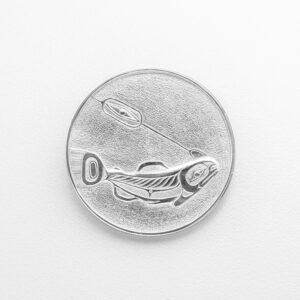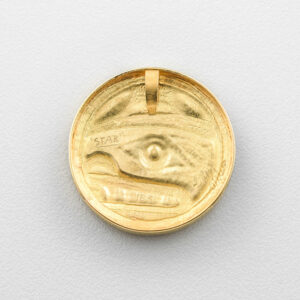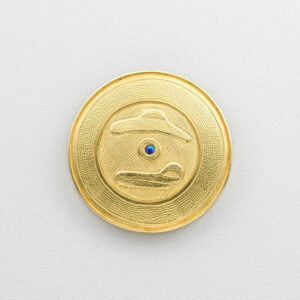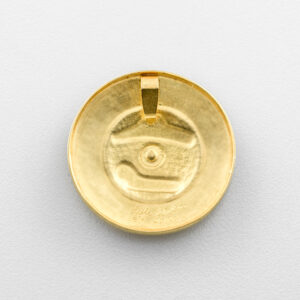Lyle Wilson
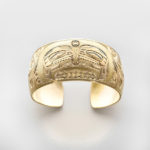
Haisla Nation
Born in 1955, Lyle Wilson is a Haisla artist from Kitamaat Village, which is near the town site of Kitimat, British Columbia, Canada. The Haisla Nation is often referred to as Northern Kwakwaka’wakw; however, their historic artistic style has influences from various sources – notably Kwakwaka’wakw and Tsimshian, as well as developing distinctive qualities of their own. The name Kitamaat means, “People of the Snow” and refers to the large amount of snow received by this region. Tsimshian people visiting the Haisla people in mid-winter arrived to see people emerging from big houses completely buried by the snow so the name Kitamaat seemed an appropriate description.
The Haisla Clan system is matrilineal and although he was born into the Beaver Clan, Lyle was formally adopted into his father’s Eagle Clan. Due to the high death rates at this time, his Eagle grandmother formally adopted both Lyle and his sister to help ensure the continuation of the Eagle Clan. This was a small but important event, which helped shape Lyle’s view of Haisla culture.
Lyle was always conscious and appreciative of Haisla art, which was present in his formative years. In this regard, his first artistic influence was his uncle, Sam Robinson, who is a full-time carver. Fascinated, Lyle watched him and occasionally whittled to the best of this abilities. He did not pursue art as a possible profession until he attended the University of British Columbia. At this time, he committed to a career in art education, but found time spent in the studio more compelling – eventually leaving to pursue his own artistic interests at the Emily Carr College of Art and Design. He graduated with a diploma in printmaking and began to develop his individual style. This artistic style has its roots in graphics, but also envelopes his three-dimensional works in wood and jewelry.
Today, a renowned artist, Lyle works closely with University of British Columbia’s Museum of Anthropology where he has further pursued his interest in replicating historic Haisla art for future generations to understand and visualize. Lyle has been involved with many important private and public commissions that have aided in the awareness of Haisla art.
Additionally, he has been involved in a number of group and solo exhibitions since 1981 both locally and abroad. Some of his public commissions can be viewed at the Museum of Anthropology, BC Sports Hall of Fame, Canadian Consulate in Osaka, Japan, Canadian Institute for the Blind, EXPO 1992 and at the UBC First Nations House of Learning.
Works by this Artist (Present + Past + Public)
Present Works
-
Trophy Pendant
Lyle Wilson
CA$1,700.001976 Montreal Olympiad $5 Dollar Silver Coin, Deeply Sculpted, Engraved, Textured
2014“This pendant is an example of the traditional Pacific Northwest Coast formline style being adapted to show a relatively modern event. About 30 years ago, my uncle G’psgolox (Dan Paul Sr.) took me to visit some Tsimshian relatives at their fishing camp, which was located way out, and close to the open ocean. G’psgolox stayed in his bigger boat while a Tsimshian friend took me trolling in a small boat. Using a rod and reel, we hooked the biggest spring salmon that I’ve ever caught – over 40 pounds. The size of that salmon has remained in my mind ever since and so I memorialized that event in this silver coin.
The silver coin is thicker than standard silver stock, so it allows me to carve extra deep to give a sculptural look to the pendant. The pendant’s back is left as is to show its beginnings as a coin.”
-Lyle Wilson, 2016
-
Star Face Pendant
Lyle Wilson
CA$5,400.0018K Yellow Gold, Abalone shell, Engraved, Textured, Repoussé, Chased
2012“The story of ‘Raven Releasing the Light’ has several versions depending upon the teller and the Pacific Northwest Coast group. In some versions, the sun is featured, while in others the moon or stars are included. In this pendant, I played around with the idea of using a star; it’s a theme I want to keep on pursuing because it’s intriguing to me to take bits and pieces of a traditional tale and expand it in a way that respects the original intent. As far as I know, a Star is not really widely used in Pacific Northwest Coast art.”
-Lyle Wilson, 2016
-
Ovoid Eyespot #3 Pendant: Human
Lyle Wilson
CA$5,100.0018K Yellow Gold, Abalone shell, Engraved, Textured, Repoussé, Chased
2012“For this series, the inspiration came from thinking about the eyespot markings on the wings of young skatefish; as such markings are credited with the beginning of the famous Pacific Northwest Coast (PNC) Ovoid. The original markings are solid black spots, encircled by a fine line.
I wanted to use the same circular format as a young skatefish’s markings as traditionally as can be, but with variations on each face. There’s a strong ‘pull’ that keeps an artist coming back to the more traditional, straightforward depictions of PNC faces. To those of us who grew up hunting, gathering and fishing, I think such a ‘pull’ is connected to that traditional upbringing; and that sort of familiarity makes us want to go back, just to remind us of our roots again.”
-Lyle Wilson, 2016
-
Ovoid Eyespot #6 Pendant: Human
Lyle Wilson
CA$4,800.0018K Yellow Gold, Abalone shell, Engraved, Textured, Repoussé, Chased
2012“For this series, the inspiration came from thinking about the eyespot markings on the wings of young skatefish; as such markings are credited with the beginning of the famous Pacific Northwest Coast (PNC) Ovoid. The original markings are solid black spots, encircled by a fine line.
I wanted to use the same circular format as a young skatefish’s markings as traditionally as can be, but with variations on each face. There’s a strong ‘pull’ that keeps an artist coming back to the more traditional, straightforward depictions of PNC faces. To those of us who grew up hunting, gathering and fishing, I think such a ‘pull’ is connected to that traditional upbringing; and that sort of familiarity makes us want to go back, just to remind us of our roots again.”
-Lyle Wilson, 2016
Past Works
The artist’s Past Works at our Gallery have now sold; however, a custom order may be possible if the artist is available and accepting commissions.


